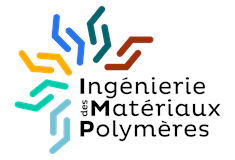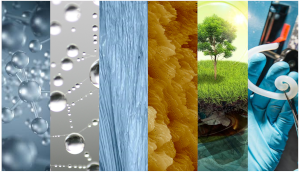Dispersion state, interfacial phenomena and dielectric properties in high-permittivity polymer-based nanocomposites
Effet de l'état de dispersion et de la modification de surface de particules à haute permittivité sur les propriétés diélectriques de nanocomposites à base polymère
Résumé
Polymer-based nanocomposites with high-permittivity are of main interest for insulating materials for dielectric use like energy storage. Their design consists in finding the best compromise between the good electrical insulating properties of the matrix and the high permittivity of the filler. The control of the filler dispersion state, the interfacial feature and the electronic structure is essential in order to control the dielectric properties in nanocomposites. The methodology proposed in this work has consisted in controlling the dispersion state of BaTiO3 Nanoparticles (NPs) in PVdF-HFP matrix in order to separately study the effect of NP dispersion state, of interfacial features and of electronic structure on the dielectric properties in nanocomposites. An extended study of the Hansen interaction parameters has allowed a rationalization of the nanocomposites solvent casting process, from the quality of the polymer matrix to the dispersion state of the NPs. The Hansen Solubility Parameters (HSPs) and Hansen Dispersibility Parameters (HDPs) of PVdF-HFP and BaTiO3 NPs were experimentally determined by solubility test and sedimentation tests, respectively. Scanning Electron Microscopy (SEM) and Dynamic Light Scattering were used to characterize the NP dispersion state throughout the fabrication process. Two methodology based on the selection of a solvent with appropriate HSP values was proposed to control the NP dispersion state in nanocomposites. The fabrication of PVdF-HFP:BaTiO3 nanocomposites with either well dispersed or agglomerated particles has allowed studying the effect of NP dispersion state on dielectric properties at low electric fields. They were characterized by Broadband Dielectric Spectroscopy (BDS) and High Frequency Dielectric Spectroscopy (HFDS). Two different effects were found to depends on both the NP content and their dispersion state: 1- The amplification of the matrix permittivity by the high-permittivity fillers was found to increase with BaTiO3 NP content and to be higher in nanocomposites with agglomerated NP as compared to well dispersed. The presence of occluded polymer inside the agglomerates that leads to increase the effective content of NP has been proposed to explain such effect of the dispersion state 2- An additional Maxwell-Wagner-Sillars polarization related to water-assisted charge carrier conduction at the surface of the NPs was found to have larger magnitude in nanocomposites with agglomerated NPs as compared to well dispersed NPs. The local percolation of the interphases within the agglomerates was proposed to explain this result. Finally, surface modifications of the NPs were performed with either PMMA or alkyl chains. The modified NPs were characterized by Fourier Transformed Infra-Red (FTIR) spectroscopy and Thermogravimetric Analysis (TGA). The stability of the NP suspension in some solvents was affected by surface modification, which is interpreted as a proof that HDPs can be modified by NP functionalization to tune the interactions in nanocomposite fabrication process and control its dispersion state. Nanocomposites were prepared with the modified NPs and BDS and HFDS were used to characterize their dielectric properties. No significant effect of the surface modification was found at low electric fields. However, the modification process is thought to have introduced impurities responsible for unexpected dielectric behaviour as compared to nanocomposites filled with as received NPs.
Dans le domaine des matériaux nanocomposites isolants électriques à base de polymères, les propriétés diélectriques peuvent être ajustées en modifiant la composition et/ou la morphologie du composite (rapport d'aspect, orientation, état de dispersion...). La modification de la chimie de surface des particules constitue également un outil de design des propriétés diélectriques des composites via la modification des propriétés à l’interfaces entre les particules et la matrice. Largement mentionnée dans la littérature, la modification de surface des particules entraîne bien souvent une modification de l’état de dispersion des particules dans les matériaux composites finaux. L’interdépendance entre les propriétés aux interfaces et l’état de dispersion complexifie la déconvolution de leurs effets respectifs sur les propriétés diélectriques et donc l’étude des mécanismes et phénomènes physiques impliqués dans les relations structure-propriétés. Cette étude expérimentale a pour but d’approfondir la compréhension de ces mécanismes en dissociant la modification de surface des particules de l’état de dispersion obtenu dans les composites. Pour cela, des nanocomposites à matrice PVdF-HFP chargés de nanoparticules de BaTiO3 ont été choisis comme système d’étude et fabriqués par voie solvant. Ces travaux constituent une approche globale prenant en compte les interactions moléculaires à l’œuvre durant le procédé de fabrication des nanocomposites, l’état de dispersion des particules, et jusqu’aux propriétés diélectriques macroscopiques qui en découlent. Ces travaux offrent une ouverture à l’approfondissement de ces relations structure-propriétés en caractérisant de manière plus poussée la structure même des agglomérats et son effet sur les propriétés diélectriques et de transport de charges dans les nanocomposites à haute permittivité. L’étude des propriétés diélectriques à fort champ de ces matériaux, et cela jusqu’au claquage, pourrait également permettre d’approfondir la compréhension des mécanismes de transport de charges et mettre en évidence l’influence des propriétés aux interfaces.
Origine : Version validée par le jury (STAR)


